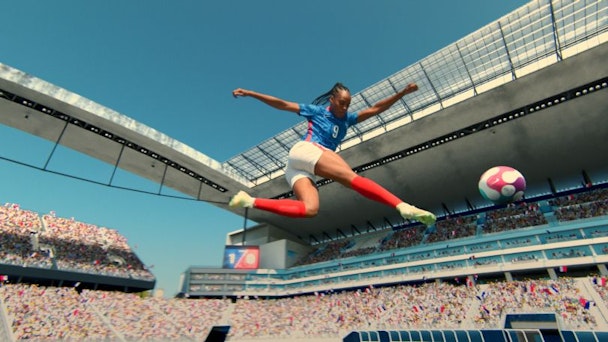What’s next for women’s football? How brands can help build momentum beyond Euro 2022
Ahead of England’s Euro 2022 final match against Germany, and after some long overdue investment from brands, James Corcoran of sport and entertainment agency Fuse considers how commercial partners can help change the women’s game forever.

Nike’s stylish and high-energy ‘Never Settle, Never Done’ ad / Nike
Women’s football has come a long way. I remember attending the first FA Women’s Super League game at Imperial Fields at Tooting & Mitcham FC between Chelsea and Arsenal back in 2011. It had a match day attendance of 2,510 and the pitch was in such bad condition it looked like a sandpit! At the time, the top tier of women’s football in England was played throughout the summer months to avoid any clashes with the men’s game. Furthermore, many players were semi-professional with most having second jobs. Commercially, rights holders would ‘bundle in’ the women’s game as added value when brands were negotiating men’s football sponsorship deals.
Fast forward 12 years and the growth of the game has been dramatic. Over 68,000 fans attended the Euro 2022 opening match between England and Austria at Old Trafford making it the biggest crowd ever recorded at the European Championships. Furthermore, the tournament is now the most attended Women’s Euros of all time with plenty of games to spare. Tickets to the Final at Wembley on Sunday, July 31 are sold out and while it will fall just short of the current matchday record attendance set by Barcelona v Wolfsburg during the Uefa Women’s Champions League semi-final, it will still be a major game-changing moment for the sport, especially in England.
From a broadcast perspective, Uefa is hoping to break even more records by reaching over 250 million viewers globally thanks to multiple broadcast deals across 195 territories. Almost 5 million Brits watched England’s 8-0 win over Norway live on BBC1, including its digital platforms, which is huge. Moreover, players such as Lucy Bronze and Leah Williamson are household names and, commercially, the women’s game is being ‘sold’ in its own right to global brands.
The continued growth of women’s football has not happened by accident, nor has it happened overnight. Governing bodies such as the Football Association (FA) have reshaped the game over many years. To make women’s football popular and attractive to commercial partners and broadcasters, it first had to start at the top of the pyramid. This meant England players were put on central contracts with higher pay (no more second jobs), training facilities such as St George’s Park were used to deliver better on-pitch performances (no more sandpits) and the domestic game mirrored a more traditional football season.
This comes with challenges of course as competing for match day attendances against the men’s game can be problematic; but then again, the women’s game fan experience is also different – and so it should be. Tickets are much more affordable, the match day experience is extremely family-friendly and less ‘tribal’ than the men’s, plus, the players are very down-to-earth and approachable – they often stay after matches to sign autographs and talk to fans.
With the elite women’s game being more professional and players becoming more inspirational, there is a trickle-down effect to grassroots – which in turn grows the game from the bottom up and attracts and engages new audiences.
Globally, interest in women’s football has grown by 46% over the last decade, with over 330 million people interested in the sport. It’s figures like this that attract commercial investment from sponsors. As such, brands such as Pepsi Max, Walkers and Doritos are investing significantly in through-the-line campaigns thanks to PepsiCo’s global sponsorship of the Women’s Euros. Its integrated marketing campaign runs across digital, social, PR, POS, OOH and on-pack promotions (featuring Lucy Bronze, Nikita Parris and Leah Williamson), which reinforces PepsiCo’s vision of driving inclusivity and gender equality across the entire game – men’s and women’s.
Despite a rise in commercial deals, awareness of women’s sports sponsorships in the UK is 50% lower than awareness of sports sponsorships generally, according to a survey from the Onside consultancy firm. The Women’s Euros presents an opportunity to change this and, thanks to brand campaigns such as Nike’s stylish and high-energy ‘Never Settle, Never Done’ ad that shows women and girls flawlessly playing football, it will be interesting to see what impact sponsor activity has had on fans following the Women’s Euros.
So, after what is looking like a real tent pole moment for women’s football in England thanks to the Women’s Euros, what’s next for the game and how can the sport continue to build momentum? Of course, continued investment from sponsors will play an important role in communicating the game to new audiences, but the onus will largely be down to the FA and domestic clubs to leverage a heightened interest in the sport while continuing to give platforms to players to help grow their profiles and inspire the next generation. I’d like to see match-day attendances grow domestically and more fixtures played in larger stadiums at key moments throughout the season.
But perhaps the biggest legacy the Uefa Women’s Euros can leave England is an uplift in grassroots football. Sport, especially football, has such an important role to play up and down the country in local communities – it not only contributes to physical and mental wellbeing, but it can also help to teach key life skills such as teamwork and discipline. Ultimately, for the women’s game to continue to grow, it will need an integrated approach from marketing, commercial and communications from a range of football stakeholders and commercial partners.
